Disappeared people
In 2006, the United Nations (UN) General Assembly adopted the International Convention for the Protection of All Persons from Enforced Disappearance. Article 2 of the Convention stipulates:
enforced disappearance is considered to be the arrest, detention, abduction or any other form of deprivation of liberty by agents of the State or by persons or groups of persons acting with the authorization, support or acquiescence of the State, followed by a refusal to acknowledge the deprivation of liberty or by concealment of the fate or whereabouts of the disappeared person, which place such a person outside the protection of the law.
Russia is not a party to the Convention. Nevertheless, in 2001 the Russian Ministry of Defense approved the “Manual for the application of norms of international humanitarian law by the Armed Forces of the Russian Federation”. The manual lays down the obligation that prisoners of war, and especially civilians, must at all times be treated humanely by parties to a conflict, while military commanders should take steps to search for the dead and missing, irrespective of their affiliation to the conflict.[1]
Despite this, numerous cases of disappearances during the war in the Chechen Republic were recorded by various human rights organizations, including the Memorial Human Rights Centre, Human Rights Watch, Society of Russian-Chechen Friendship and many others. Furthermore, the European Court of Human Rights (ECtHR) in its judgments found violations against Russia, in connection with unlawful detentions and subsequent disappearances of residents of the Chechen Republic.
5,131 disappeared persons are registered in the Natalia Estemirova Documentation Center Database (hereinafter the Database).[2] It is certain that of these, 2,220 persons, that is 43% of those registered, disappeared during zachistkas carried out by the Russian Armed Forces. 2,911 persons, or 57% of the total number of recorded persons, disappeared in circumstances unrelated to such operations.
A more detailed classification of the circumstances in which people have disappeared is demonstrated in chart 1 and reveals the following: 633 persons (12%) disappeared in the course of large-scale operations conducted in rural municipalities (organized large-scale zachistkas in which major groups of armed forces and police were deployed with the use of military equipment) covering the greatest number of civilians; 1,580 persons disappeared as a result of targeted, local operations carried out against particular persons or groups of persons (in such cases people were taken from their homes during the zachistkas, from their workplaces or at checkpoints etc.); 1,663 persons disappeared as a result of random abductions in various circumstances which proved difficult to systemize. People were often abducted on the street and taken away leaving no possibility to trace their whereabouts; a person could just walk out of their home and never come back. Relatives and random witnesses would often submit information about the circumstances of the abductions to human rights organizations. 1,200 persons have disappeared in the Chechen Republic under unknown circumstances. This group also includes missing people whose names were mentioned in various lists without detailed information about them. 55 incidents of such disappearances require additional analysis and research.
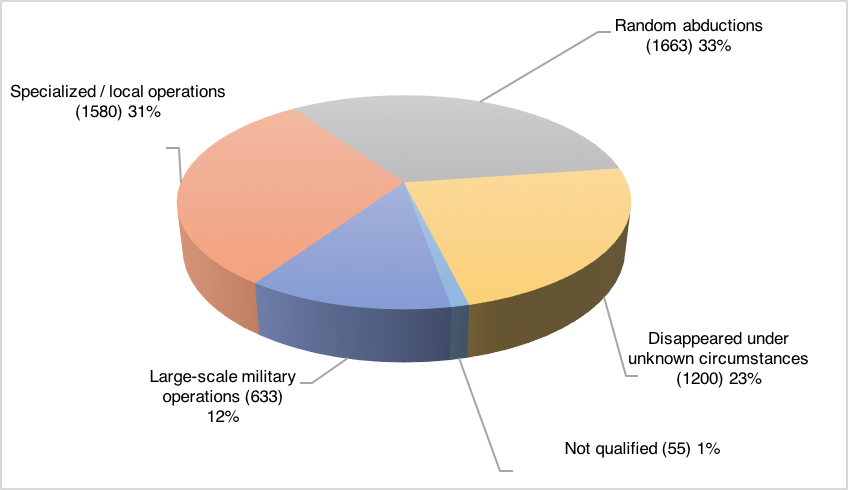
4,770 people, or 93 % of the total number of disappeared people, are male: 114 of them are minors and 98 are over the age of 60. At least 360 girls and women disappeared in the Chechen Republic during the conflict: 33 of these were minors and 17 were over the age of 60.
With respect to the status of the victims under international humanitarian law, it has been established that over 70%, or 3,679 persons, were civilians, including amnestied persons (as displayed in chart 2). At least 245 persons were combatants and 11 disappeared persons took part in the hostilities, though not regularly. Another disappeared person, marked as not actively taking part in the conflict, was the head of the passport office of one of the District Offices of the Interior (ROVD) in Grozny. He was taken at night from his house by the military.[3] The status of 1,195 persons is impossible or difficult to determine.
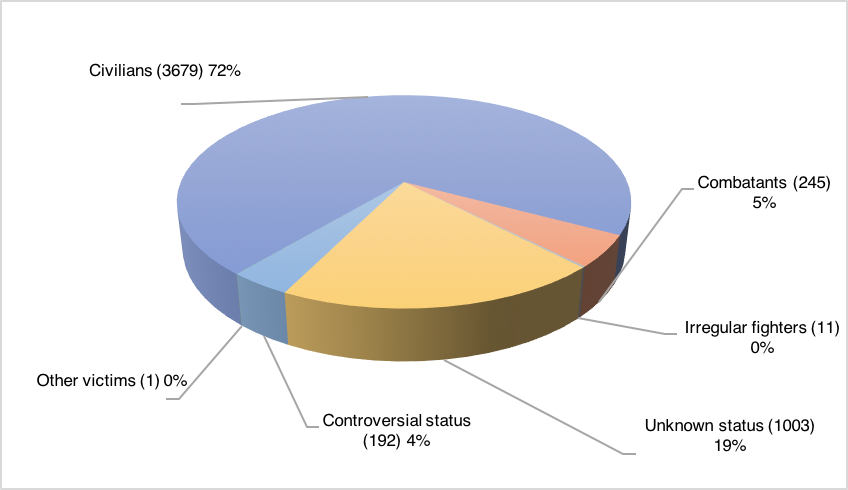
In many cases, people were kidnapped from their own home; it has been established that there were at least 1,705 such victims. There were many situations during the conflict in the Chechen Republic where camouflaged armed men would storm into a victim’s house, lift them from their bed and take them away in an unknown direction, beating them with arms, legs and machine guns.
By way of illustration, the following is how a resident from the village of Kurchaloy described her brother’s, Mr I.’s, kidnapping in July 2002:
At about 4 a.m. the neighbor´s dog began to bark loudly. I was sleeping by the window. I looked outside and saw armed men in camouflage storming into the courtyard. I only managed to put my dress on when, threatening with weapons, and shouting “do not move, or we will kill” they broke into my room. My two brothers were sleeping in a separate room. I do not know what happened there as my mother and I were not allowed access to them. Not only to them, but neither to the five-year-old nephew, who was also at gunpoint. After the military left, the child could not recover for a long time. Armored personnel carriers and UAZ vehicles arrived later. After the military left, taking I. with them, we learned that they knocked out my older brother by hitting him in the head with a gun. My father, who was about to leave for the morning prayer, was also pushed backwards with a butt blow. And I. was taken away.[4]
After 2005, cases of such kidnappings using armored personnel carriers (APCs) or other equipment became less frequent. However, the method remained the same.
For example, one day in October 2007 at 4.30 a.m. three armed, camouflaged men broke through a window into the house of a resident from the village of Voykova near Grozny. Only one of the kidnappers spoke Russian without an accent. Holding those who were in the room at gunpoint, the unknown men asked for the owner of the house who was in the bedroom with his wife and small child. As soon as they saw him, they attacked him and started beating him with their machine guns. The man did not resist. His wife attempted to intervene but one of the attackers pointed his gun at her. The victim was then only able to put on his pants before a black bag was taped over his head and he was forced to leave with the armed men. In the morning, the victim’s relatives filed an application to the prosecutor’s office, but the criminal case was only initiated ten days later. Since then, nothing has been known about the victim.[5]
The abovementioned pattern of kidnappings occurring during the night was quite common. In total, 879 incidents of such disappearances have been recorded. It is of note that a curfew was imposed in the Chechen Republic during the counter-terrorist operation which only permitted the military to move freely during the night. Hence, it is highly likely that representatives of the federal forces were responsible for the kidnappings of individuals, especially those who were taken from their own homes. It has been established that at least 264 persons disappeared at checkpoints set up by the federal authorities. This suggests that representatives of the armed forces or law enforcement agencies may have been responsible for the disappearance of these people. For example, on 13 September 2000 at the checkpoint in Urus-Martan, unidentified law enforcement officers detained a 24-year-old and a 30-year-old local resident. Subsequently, the father of one of them told:
10-15 minutes after the detention, I approached the checkpoint located in front of the factory and asked their commander why they had arrested my son and his friend. The commander replied that he did not know the people who did this. He explained that 6-7 people dressed in military camouflage uniforms approached the checkpoint and presented GRU certificates. The same people detained his son and his friend. During our conversation, the gates of the factory opened and a gray UAZ car with tinted windows and without license plates left the yard, driving at high speed. I did not see those sitting in the car. The commander with whom I was speaking said that they had left in this car.
It is noteworthy that in this case the ECtHR established that the violation was committed by the Russian authorities and also found Russian security forces responsible for the kidnapping of the men.[6]
In some cases, relatives of the victims conducting their own investigation were able to ascertain the whereabouts of their fathers, husbands, brothers or sons. It is a well-known fact, for instance, that people were often taken to the military base in Khankala, the remand prison in Chernokozovo located in the Naursky District, the ORB-2 or various police departments and Departments of Internal Affairs (VOVD). They were subsequently transported to different locations. It remained a consistent pattern that relatives lost track of the location of the victims at this stage and no further information regarding their fate could be found.
One such example is the case of a resident of the Vedeno District whose sons were kidnapped by the military in July 2001. Two weeks after the kidnapping, the mother received a note from her sons in which they informed her about the whereabouts of their detention. Through the help of an employee from the regional Ministry of Interior department for the fight against organized crime (RUBOP), the mother learned that her sons were detained in the Federal Security Service (FSB) office in the Shalinskiy District. The deputy military commander told the woman that he had been promised to be shown the cells in which the two detainees were being held. However, they were subsequently told that the brothers had allegedly been transferred to the district center of the village of Vedeno. Since then, no new information has been provided regarding their fate.[7]
It has been established that at least 422 persons disappeared at filtration points or places of restriction or deprivation of liberty. At least 217 persons disappeared at the military base in Khankala alone, and at least 33 in the infamous Chernokozovo SIZO detention center. The remaining victims disappeared in ROVD, VOVD, OMON (Special Purpose Mobile Units) bases, various detention centers or temporary filtration camps.
In relation to the geographical distribution of the disappearances in the Chechen Republic (chart 3), Grozny ranks first with at least 1,700 disappeared people. This is followed by the Shalinsky District with 495 disappeared persons and then the Urus-Martanovsky and Groznensky Districts. These most populated areas are located in the central part of the Republic, close to Grozny. In the more remote areas of the Chechen Republic, such as Itum-Kalinsky, Sharoisky, and Shatoi, the number of disappeared people registered in the Database is much lower. These are, generally speaking, hard-to-reach mountainous areas where it was difficult for human rights activists to gather information about the victims of the war.
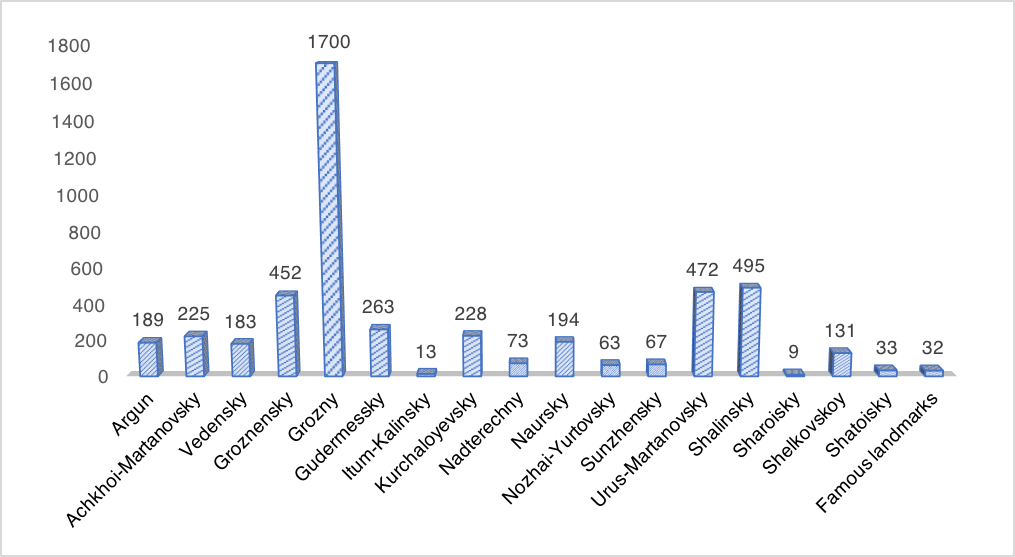
The analysis of the materials allows the following conclusions to be made about the status of disappeared people in the Chechen Republic (chart 4):
- 2,698 persons (53% of all those who have disappeared) were civilians who had suffered from the actions of the Russian Federal Forces;
- 961 persons (19%) were civilians, who suffered from the actions of unidentified forces;
- 19 civilians (0.3%) disappeared as a result of actions by insurgents;
- 169 victims worked in local law-enforcement bodies;
- 34 disappeared persons were seconded from other regions of Russia;
- 60 missing persons were members of armed groups opposing the federal forces; and
- the statuses of 1,190 persons who have disappeared are difficult or impossible to determine in view of available information.
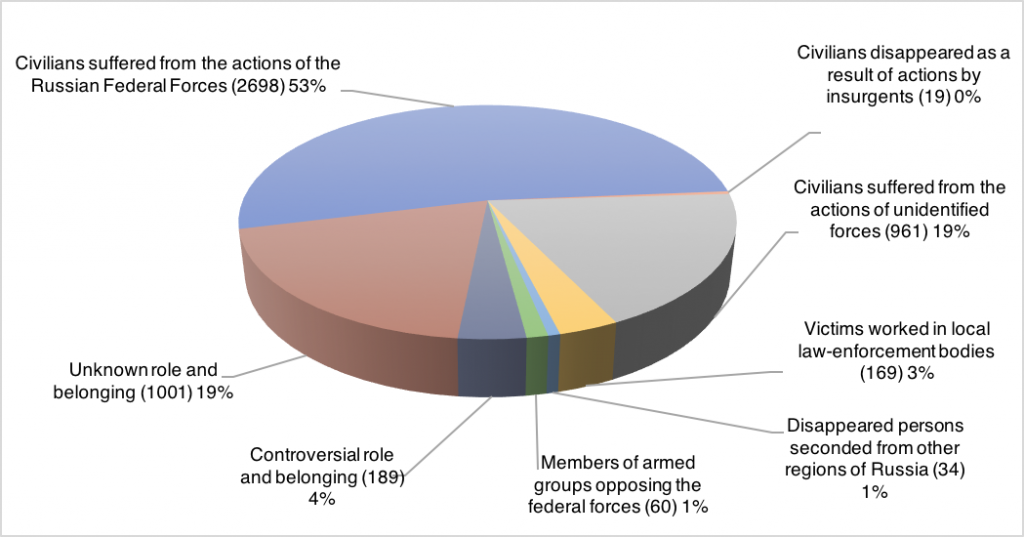
The relevant statistics provided were updated on 14 May 2019 and again on 16 May 2019.
The data is subject to change in view of the ongoing work by the Natalia Estemirova Documentation Center on the search and identification of victims of the armed conflict.
Audio library
Listen to the story of a missile attack on the village of Shaami-Yurt and the detention of its inhabitants.
For details on this story, see the “Audio” section.
Media library
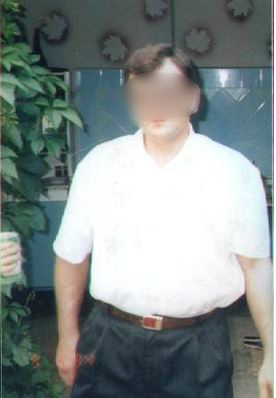
NEDC document 26614 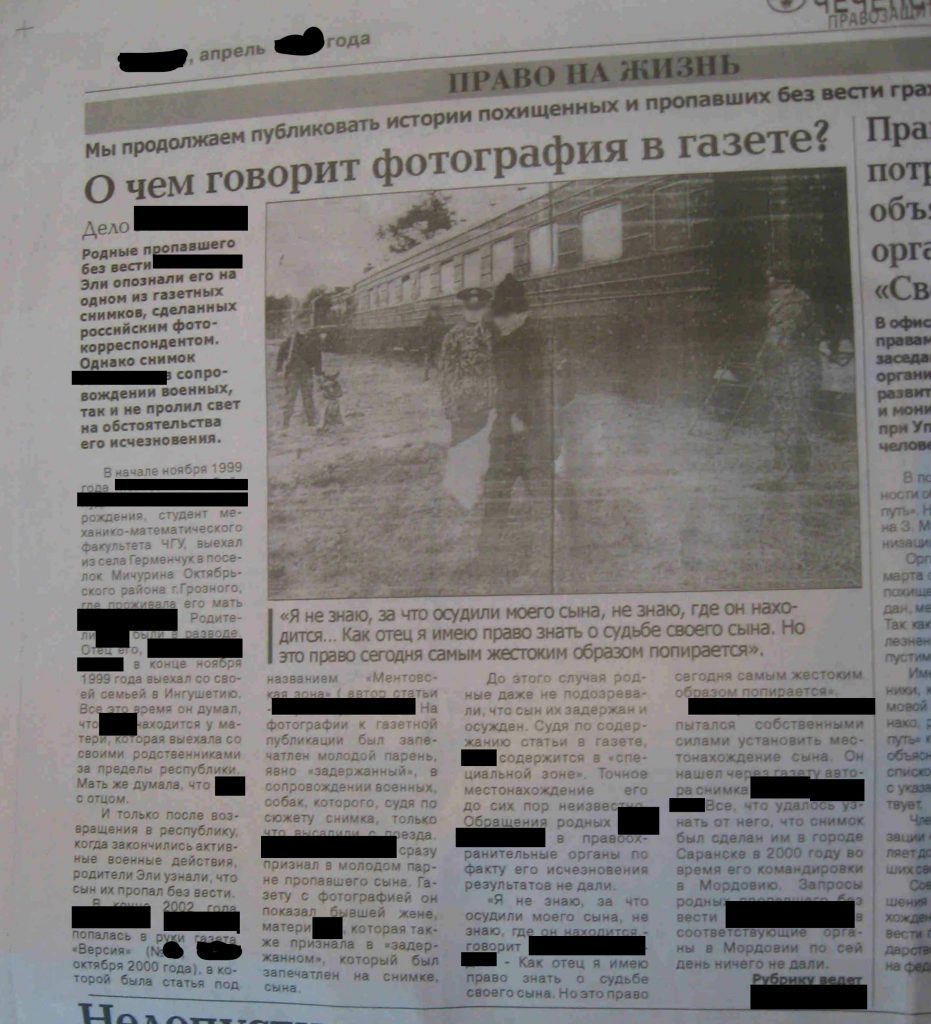
NEDC document 26806 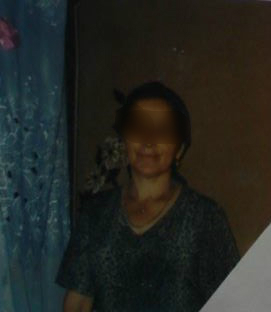
NEDC document 23755 
NEDC document 27923 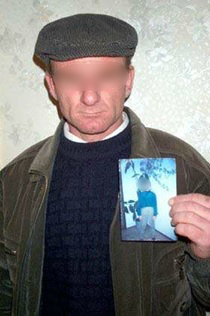
NEDC document 27919 
NEDC document 25061
References
[1]A Manual on International Humanitarian Law for the Armed Forces of the Russian Federation (approved by the Minister of Defense of the Russian Federation 08.08.2001), § 72.
[2]The statistic does not include residents of the Chechen Republic who had been abducted in neighboring regions, as well as residents of Ingushetia, Dagestan and other republics of the North Caucasus, who have been victims of abductions and unlawful detentions in connection with the armed conflict in the Chechen Republic. The Database mainly contains information about violations committed during the period of the second armed conflict that started in 1999. However, it also contains sporadic facts recorded during the first armed conflict.
[3]Victim № 45528.
[4]Incident № 2176 «Kidnapping of a resident and subsequent zachistka in Kurchaloy, July 2002».
[5]Incident № 5166 «A Kidnapping of M.A.I., Grozny, October 2007».
[6]Judgment of «Abaeva and Others v. Russia» (Application No. 37542/05), April 8, 2010.
[7]Incident № 782 «Kidnapping of two brothers in the village of Selmentauzen, July 2001».
